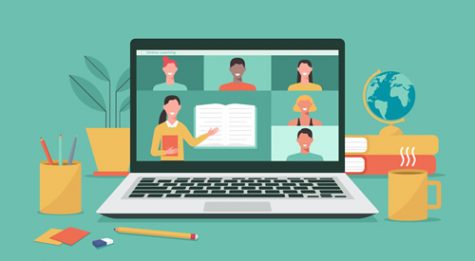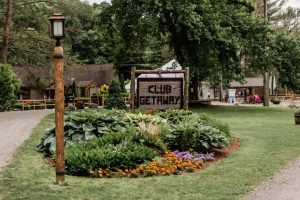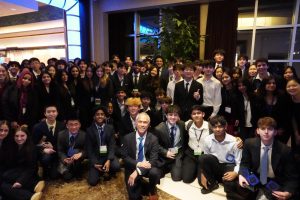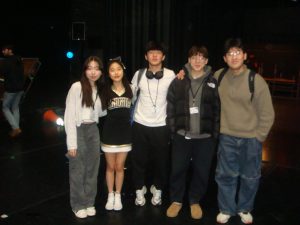Education in the Post-COVID Era
February 25, 2021
Although there had always been talk about online schooling before the pandemic, never before had all schools around the world been forced into it like this past year. After months of running schools virtually, many predict the continuum of online learning even after the pandemic passes. Educators around the world have realized that remote learning offers a wide range of different teaching styles and methods including asynchronous instruction, pre-recorded lessons, and other web-based learning through programs like Khan Academy, Duolingo, Pear Deck, etc. Some even argue that online instruction has improved the quality of teaching because of options like pre-recorded videos.
Another major benefit that the pandemic has brought not only to schools, but to all people around the world is increased convenience and accessibility. Now that all events and programs are run virtually from the comfort of your own home, there is much less time and energy spent commuting. At various universities, professors shared that they were able to invite guest lecturers from around the world. Many educators, including teachers at Bergen County Academies, have mentioned increased accessibility for certain courses, presentations, etc.
However, running online school during the pandemic has not all been easy. With the sudden switch to online school, both educators and students were faced with challenges around “Zoom fatigue” and online standardized tests. STEM schools, including BCA, faced additional challenges regarding the research courses that are normally offered in person at the lab. Without physically being present in a lab, many research courses were postponed or even cancelled this past year. Even if some research programs were still run online, many students were only able to watch their teachers conduct experiments instead of running the experiments themselves.
Lynn Huntingser, professor of Rangeland Ecology and Management as well Associate Dean of Instruction and Student Affairs at UC Berkeley, sent each of her students their own lab kits which included specimens, seeds, jars, and equipment for a soil lab. With these materials, students were able to replicate experiments that would normally be run in a greenhouse in their own homes.
Another obstacle that many university students were faced with was finding internships. Similar to BCA, upperclassmen in certain universities are required to get an internship in order to graduate. Jennifer Vanos, Assistant Professor in the School of Sustainability at Arizona State University, ended up creating her own internship opportunities with her lab. Because many companies are not hiring interns at the moment and few have virtual internships ready and running, she decided to create her own internship right at the school.
Keeping both the pros and cons of online learning in mind, the question at hand is not whether or not online learning will continue. It is how to effectively integrate and improve both online and offline learning in the post-COVID era. Because it is highly likely that online learning will stay even after the pandemic, it is essential to start brainstorming ways that both online and in-person learning can be used effectively and simultaneously in classrooms.
Many university professors expressed hopes to distribute pre-recorded lectures before class and spend the time in-person interacting with their students. This could be one possible way to use the time in-person effectively to ensure that students fully understand concepts that they learned about through the pre-videos that were sent to them.

The Center for Universal Education (CUE) launched real-time scaling labs with local institutions from various countries including the U.S. to gather evidence and practical recommendations for improving education globally. Through these scaling labs, researchers are responsible for gathering information and feedback on which systems and procedures seemed to work best. This approach is similar to what we call improvement science: real-time documentation, feedback, reflection, and corrections. As people try to restructure education systems with new approaches, especially in the post-COVID era, improvement will be more rapid and effective if everyone could share their experiences and insight on what seemed to work and what didn’t.
Here at BCA, many teachers are already planning and thinking about what changes will be made in their own classrooms after the pandemic. Mr. Hathaway, a language arts teacher and advisor for the Academy Chronicle, talked about the literature journals, where students write personal responses every week. He shares, “Realizing that we are all ‘home alone’ as far as studies go, I’ve made even more of an effort to personalize the literary responses, really tie our readings into our lives.” Even after the pandemic, Mr. Hathaway shared his plans for continuing these journals. “The responses have been so enriching, insightful, and thoughtful. When I return, I will continue to focus my journals on how the literature relates more to the students’ lives rather than its opposite.”
Despite all that has been lost from the emergence of COVID-19, the pandemic has given the world an opportunity to rethink and reshape education. As we continue to think of new ways and solutions to successfully restructure education in the post-COVID era, it is important to make the process a collective effort. Opinions and experiences from all students, teachers, and administrators from BCA and even around the world should be put into consideration. The pandemic has offered everyone a second chance to rebuild education, and there is no better time than now for change.






